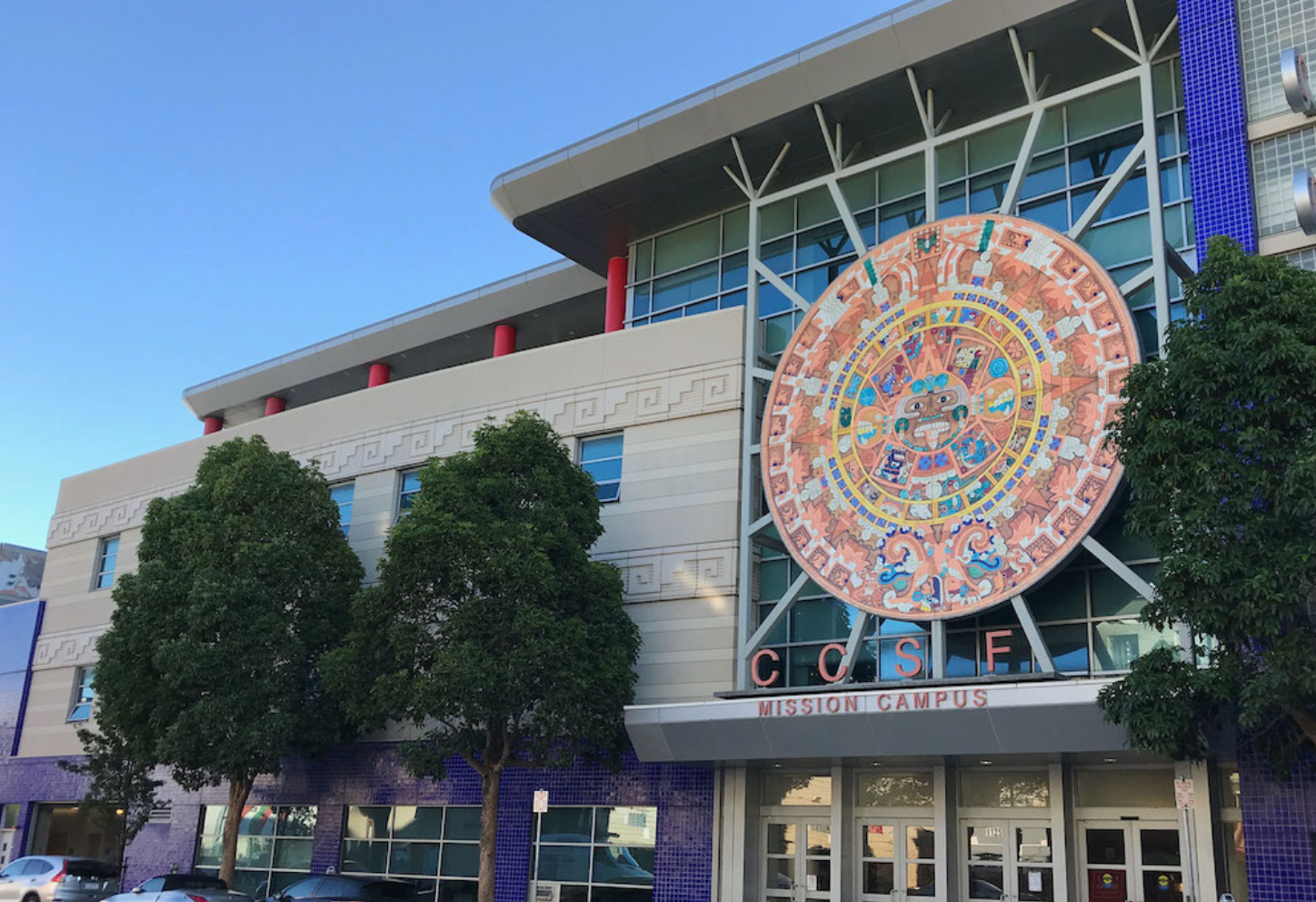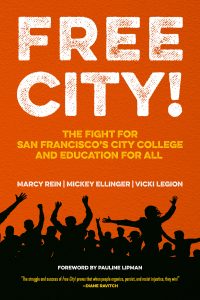By Peter Olney
Jacobin
May 2nd, 2021
Review of Free City! The Fight for San Francisco’s City College and Education for All by Marcy Rein, Mickey Ellinger, and Vicki Legion (PM Press, 2021).
After a five-year struggle against an accrediting agency trying to shut down City College of San Francisco (CCSF), a local college that serves primarily working-class students, in January 2017, staff, faculty, and students celebrated a major victory when the school was deemed fully accredited. And college tuition became free for San Francisco City residents because of a municipal ballot measure.
But the fight isn’t over. On March 12, over seven hundred students and faculty rallied on campus and at city hall to protest the issuance of 163 layoff notices for full-time faculty that will result in layoffs of 60 percent of all faculty, full- and part-time. These cuts are based on enrollment, but of course enrollment was devastated when the attack on accreditation scared away prospective students, and the pandemic has further reduced the student body.
If the school is to survive the latest challenge to its existence, it will have to continue fighting. And if similar higher-education institutions around the country are to survive the round of cuts and attacks that have been accelerated by the COVID-19 crisis, the lessons of the CCSF fight should be studied by higher-ed organizers everywhere. Luckily, such organizers can study those lessons in the new book Free City! The Fight for San Francisco’s City College and Education for All.
Free City! must have been a difficult book to write. The battle to save CCSF takes place over five years. The arenas of struggle are city, state, and federal. There are shifting alliances and electoral challenges. Strong and compelling personalities play vital roles in the fight. And the whole drama plays out amid the national push for education privatization and charter-school expansion, fueled by the Obama administration and its secretary of education, Arne Duncan.
The authors are up to the task. Lead writer Marcy Rein is a veteran labor journalist who worked for the International Longshore and Warehouse Union (ILWU) (where I was organizing director for many years) and became accustomed to covering epic battles on the waterfront and inland, covering grueling struggles to unionize recalcitrant employers like Rite Aid, Blue Diamond Growers, and Powell’s Books.
City College was founded in 1935, a year after the historic San Francisco general strike that established the ILWU as a West Coast power on the ports and in maritime warehousing. City remains an integral part of San Francisco’s social fabric. As Alisa Messer, who was president of the American Federation of Teachers (AFT) Local 2121 that led the fight to keep City College open, said: “We’re the school of second and third and fourth chances, and San Franciscans love the college.”
The Attack on Public Education
The battle to save City began in 2012, when the Accrediting Commission for Community and Junior Colleges (ACCJC) dropped the de-accreditation threat on the college. Behind a veneer of bureaucratese, the accreditors attacked the fact that City maintained an open-access vision, strong faculty collective bargaining agreements, and shared governance. This attack came in the context of attacks on public education by the Obama education department, headed by secretary of education Duncan, a champion of charter schools.
The insidiousness of these attacks, including the attack on CCSF, is part of a formula: public entities defund schools in urban areas that are attended by working-class children, often people of color. The defunding and disinvestment results in stressed out staff and outrageous class sizes — and then union teachers get blamed for the failures of these children. Private charter schools, funded by public dollars as well as liberal Democratic Party donors like Bill Gates, are then presented as the solution for public school failure.
This vicious syndrome has been given a jolt by recent teachers’ union strikes, including the brilliant work of United Teachers of Los Angeles that led up to a 2019 citywide teachers’ strike that united the community in support of staffing demands for counselors, nurses, and classroom size reduction, so working-class communities of color saw their union fighting for the future of their children. The union advanced a program of “bargaining for the common good” that acknowledged past failures of schools to meet the needs of the communities they were serving because of underfunding. The LA strike also made a successful demand for the cessation of new charter schools.
The AACJC attack was of a similar narrative, trumpeting financial problems of the school and blaming overly generous labor contracts negotiated with faculty, staff, and adjunct instructors. Much of the viciousness behind the attack was generated by the leader of ACCJC, Barbara Beno. She has been described by retired California Federation of Teachers communications director Fred Glass as a “sadistic, vengeful human being.” She was bent on punishing SF City College because the AFT faculty union had gotten her fired from her position as president of Vista College (now Berkeley City College) after filing and winning thirteen grievances against her in two years and protesting her shutdown of an innovative and effective program for working adults.
But as Local 2121 president Alisa Messer put it, “There is no one person or group behind the curtain pulling strings, many interest groups glom onto the attack.” Beno had her personal vendettas, but private colleges stood to gain by absorbing students who formerly were being educated at low-cost or free-tuition public institutions like City. The testing industry had its products to sell, and City was sitting on some prized San Francisco real estate, particularly the downtown facilities, if the college should be closed or downsized.
Decisive Leadership
Any protracted battle like the Free City! story has profiles in courage and leadership. How does such leadership develop? Where does it come from? Much attention and analytical focus has been correctly given to the transformation of the Chicago Teachers Union by a rank-and-file reform slate called the Caucus of Rank-and-File Educators (CORE), resulting in the historic 2012 citywide strike under the leadership of CORE leader Karen Lewis, who recently passed away. Similarly, the leadership of United Teachers Los Angeles was transformed by an internal reform coalition, the Union Power slate, in 2014, led by Alex Caputo Pearl.
These are very positive stories, but not universal paradigms. The case of AFT 2121 is interesting because it is a different story of organic leadership growth and development.
Alisa Messer and her successor as president of 2121 AFT, Tim Kilkelly, deserve major credit for their perseverance in holding the educational staff together through the twists and turns of this battle. Messer is a fifteen-year veteran English teacher. What is the classroom training or life experience that enabled her to provide what retired African American studies faculty member Tarik Farrar called “brilliant leadership” in this moment when the livelihoods and education of so many were in the balance?
“I employ popular education in the classroom which relies on collaboration with the students,” Messer said. That experience and basic methodology enabled her to give voice and synthesize the many visions of the many combatants in the struggle to save City.
Perhaps the biggest challenge for Messer was changing the culture of her union from an “activist” union to an “organizing” union.
“We were always an activist union taking good stances on political issues and fighting for part-timers, but we were not a deep organizing union that could move our hundreds of members. We had never had a strike in recent memory,” she said.
Bill Shields, who prior to coming to City was a skilled organizer trained with the Hotel Employees and Restaurant Employees Union (HERE) Local 2 (later becoming UNITE HERE Local 2), suggested that Alisa’s growth was also part of the union’s traditional internal culture of developing leaders by first having them serve on committees, then the executive board, and then becoming vice president, seen as the next step before taking on the presidency. Shields reflected that there had not been a contested election for president in anyone’s memory.
The challenge of transformation was vividly illustrated when Messer invited Mike Casey, the president of UNITE HERE Local 2, to help train faculty to organize each other. There was push back from AFT 2121 members who were afraid to take action. Casey responded, with some frustration, “If we can organize the undocumented to act out and take risks and strike, you can certainly move your members” to organize.
Messer is illustrative of a timeworn lesson that while the masses make history, strong leaders at crucial moments are often decisive. But a battle like this requires all hands on deck at all levels. Union locals are part of state and national organizations in part because labor battles are often fought on many levels. A valiant local can be hung out to dry by a vindictive national body.
In this case, both the California Federation of Teachers (CFT) and the national union, the American Federation of Teachers, all played a vital role. Ultimately, the power and legitimacy of ACCJC had to be attacked at the federal level and in the California legislature. CFT leader Marty Hittelman was a constant critic of Beno and ACCJC. In retirement, he wrote a brilliant dossier on them called ACCJC Gone Wild that exposed the nefarious deeds of Beno and company.
In fact, it was Hittelman’s two terms as statewide CFT President that began the transformation of that body, which culminated in the presidency of Josh Pechthalt, a veteran of the Union Power slate in Los Angeles. Pechthalt unleashed his organization’s communication and lobbying clout to assist the fight at City College.
To Victory!
Free City! is a complicated, winding tale. One might wish for more in-depth profiles of key figures like Messer and Hittelman, because leaders are crucial at pivotal moments in history. As Free City! illustrates, they do not always arise out of rank-and-file reform movements. Sometimes it is the very culture and milieu of a union and its history that incubate leadership. Other times, it is the personal political formation of individuals that shape their leadership roles. Staffers like Glass and top union elected officers like Hittelman and Messer are often crucial in welding organization together on many levels to conduct a winning battle.
For educator unionists, Free City! is a great primer on the twists and turns of the contemporary fight against the privatizers. It has a useful and easily comprehensible analysis of the national and California State players in the educational arena. It can be considered a handbook for those in the trenches. Free City! is also a deep dive into a protracted struggle that led to victory, but whose final chapters are still to be written by leaders, faculty, students, and community members who treasure City College of San Francisco.







